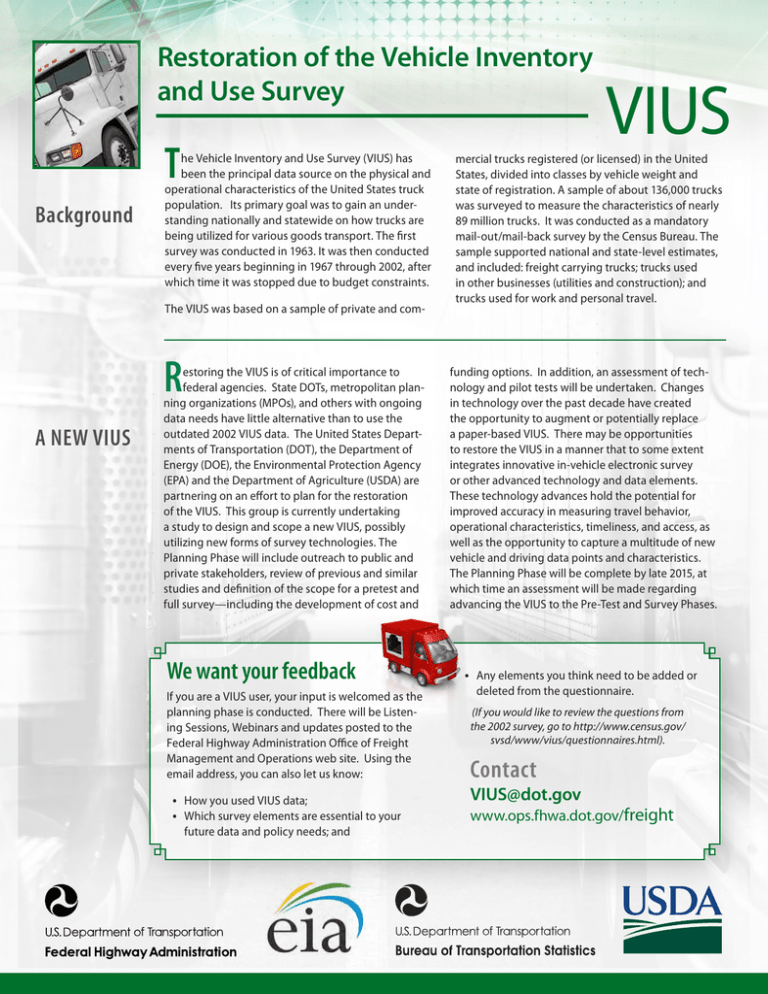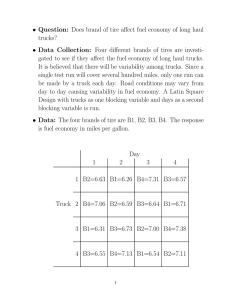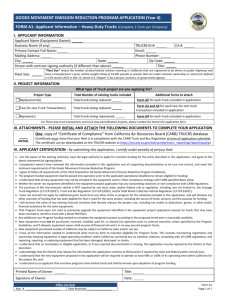VIUS T Restoration of the Vehicle Inventory and Use Survey
advertisement

Restoration of the Vehicle Inventory and Use Survey T Background he Vehicle Inventory and Use Survey (VIUS) has been the principal data source on the physical and operational characteristics of the United States truck population. Its primary goal was to gain an understanding nationally and statewide on how trucks are being utilized for various goods transport. The first survey was conducted in 1963. It was then conducted every five years beginning in 1967 through 2002, after which time it was stopped due to budget constraints. The VIUS was based on a sample of private and com- R A NEW VIUS estoring the VIUS is of critical importance to federal agencies. State DOTs, metropolitan planning organizations (MPOs), and others with ongoing data needs have little alternative than to use the outdated 2002 VIUS data. The United States Departments of Transportation (DOT), the Department of Energy (DOE), the Environmental Protection Agency (EPA) and the Department of Agriculture (USDA) are partnering on an effort to plan for the restoration of the VIUS. This group is currently undertaking a study to design and scope a new VIUS, possibly utilizing new forms of survey technologies. The Planning Phase will include outreach to public and private stakeholders, review of previous and similar studies and definition of the scope for a pretest and full survey—including the development of cost and We want your feedback If you are a VIUS user, your input is welcomed as the planning phase is conducted. There will be Listening Sessions, Webinars and updates posted to the Federal Highway Administration Office of Freight Management and Operations web site. Using the email address, you can also let us know: • How you used VIUS data; • Which survey elements are essential to your future data and policy needs; and VIUS mercial trucks registered (or licensed) in the United States, divided into classes by vehicle weight and state of registration. A sample of about 136,000 trucks was surveyed to measure the characteristics of nearly 89 million trucks. It was conducted as a mandatory mail-out/mail-back survey by the Census Bureau. The sample supported national and state-level estimates, and included: freight carrying trucks; trucks used in other businesses (utilities and construction); and trucks used for work and personal travel. funding options. In addition, an assessment of technology and pilot tests will be undertaken. Changes in technology over the past decade have created the opportunity to augment or potentially replace a paper-based VIUS. There may be opportunities to restore the VIUS in a manner that to some extent integrates innovative in-vehicle electronic survey or other advanced technology and data elements. These technology advances hold the potential for improved accuracy in measuring travel behavior, operational characteristics, timeliness, and access, as well as the opportunity to capture a multitude of new vehicle and driving data points and characteristics. The Planning Phase will be complete by late 2015, at which time an assessment will be made regarding advancing the VIUS to the Pre-Test and Survey Phases. • Any elements you think need to be added or deleted from the questionnaire. (If you would like to review the questions from the 2002 survey, go to http://www.census.gov/ svsd/www/vius/questionnaires.html). Contact VIUS@dot.gov www.ops.fhwa.dot.gov/freight Information from VIUS VIUS Applications Physical characteristics, such as • • • • • • • • • • • Body type Model year Make Loaded Weight Empty Weight Length Axle configuration Trailer configuration Equipment type Fuel type Engine size Operational characteristics, such as • • • • • • • • • • • Primary jurisdiction Operation type Refueling location Annual miles Empty miles Home-base related data Fuel efficiency Vehicle range Principal product carried Hazardous materials carried Truck fleet size VIUS data are of considerable value to government, business, academia, and the general public. Data on the number and types of vehicles and how they are used are important in studying the future growth of transportation and are needed in calculating fees and cost allocations among highway users. The data also are important in evaluating safety risks to highway travelers and in assessing the energy efficiency and environmental impact of the Nation’s truck fleet. The U.S. Department of Transportation (DOT) uses the data for freight movement analysis, highway cost allocation, truck size and weight evaluation, investment and performance analysis, commercial motor vehicle safety analysis, cost allocation studies, and system performance analysis. The U.S. Department of Energy (DOE) uses the data to assess the energy efficiency of the nation’s truck fleet, assess technology and alternative fuel penetration, and forecast truck population, activity and fuel demand. The U.S. Department of Agriculture (USDA) uses the data in support of rural transportation analysis, including truck size and weight, commodities carried, mileage, and the statutory exemptions and waivers important to farmers, ranchers, and their suppliers. The U.S. Environmental Protection Agency (EPA) uses the data to calculate vehicle emission estimates, vehicle performance and fuel economy, and fuel conservation practices of the trucking industry. The Bureau of Economic Analysis (BEA) within the U.S. Department of Commerce uses the data as a part of the framework for the national investment and personal consumption expenditures component of the Gross Domestic Product (GDP). State DOTs and Metropolitan Planning Organizations (MPOs) use the data for highway planning, air quality improvement planning, and ports and intermodal center development and planning. Businesses, such as truck manufacturers, fuel manufacturers, and private consulting firms, make use of these data in conducting market studies and evaluating market strategies, assessing technology penetration, and determining future fuel demands. FHWA-HOP-15-014





